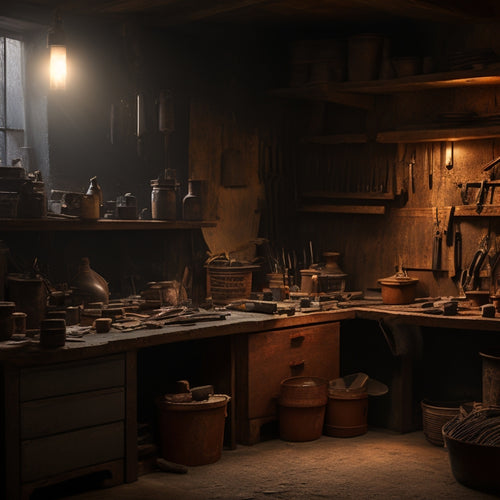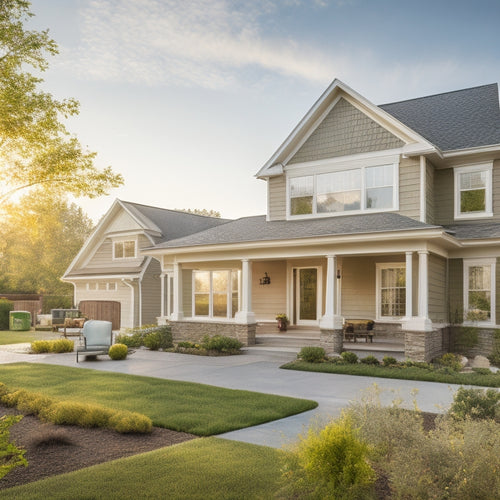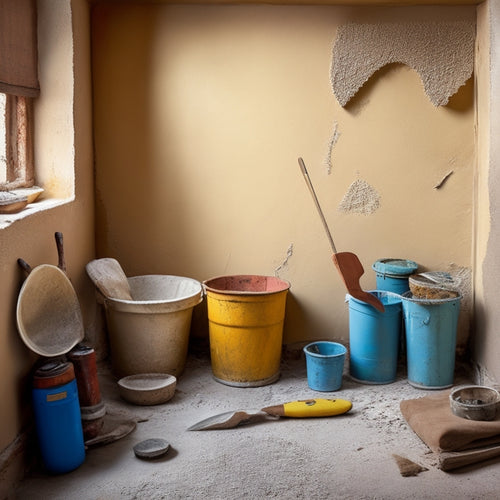
Texture Installation Tools for Home Renovation Beginners
Share
As a home renovation beginner, you'll need specific tools to achieve professional-looking ceiling texture installation. Start with essential tools like a texture sprayer, joint compound, and putty knife, which are vital for application and smoothing. You'll also require specialized materials like plaster, mixing buckets, and trowels. Additionally, invest in high-quality sanding blocks, putty knives, and trowels for texturing and smoothing. Don't forget ceiling repair and patching tools, as well as specialized tools for knockdown, orange peel, and spray textures. From there, explore further to discover the full range of tools and techniques required to master the art of ceiling texture installation.
Key Takeaways
• Invest in high-quality tools, including a texture sprayer, putty knife, and trowel, to ensure a smooth texture application.
• Develop skills and techniques through online tutorials and instructional videos to achieve desired textures.
• Choose the right plaster type and mix ratio based on environmental factors and project requirements.
• Master mixing and application techniques, including the use of a mixing bucket, paddle, and measuring cup.
• Practice sanding and scraping techniques, including grit selection and pressure application, for a flawless finish.
Tool Requirements for Ceiling Texture
You'll need a combination of specialized tools to achieve a professional-looking ceiling texture, including a texture sprayer, joint compound, and a putty knife. These tools will help you master various ceiling texture techniques, from subtle knockdown patterns to intricate orange peel designs.
As a beginner, it's important to invest in high-quality tools that will make the texture application process smoother and more efficient.
When it comes to ceiling texture techniques, having the right tools is only half the battle. You'll also need to develop the necessary skills and techniques to achieve the desired texture.
Beginner tooltips, such as online tutorials and instructional videos, can be a great resource to help you get started. By combining the right tools with the right techniques, you'll be able to create a stunning ceiling texture that adds depth and visual interest to any room.
Essential Materials for Plaster Work
As you prepare for plaster work, you'll need to select the right type of plaster and mix it to the correct consistency.
You'll also require a suitable trowel and float to apply and smooth the plaster.
Plaster Types and Mixes
When it comes to plaster work, selecting the right type and mix of plaster is vital, as different formulations cater to specific applications, environmental conditions, and desired finishes.
You'll encounter various plaster types, including lime-based, cement-based, and gypsum-based plasters. Each type has its unique characteristics, advantages, and limitations. For instance, lime-based plasters are ideal for historic restorations, while cement-based plasters are better suited for exterior applications. Gypsum-based plasters, on the other hand, are commonly used for interior projects.
When it comes to mix ratios, you'll need to take into account the specific requirements of your project. A general mix ratio for a gypsum-based plaster is 1 part plaster to 1 part sand, but this can vary depending on the manufacturer's instructions and your desired finish.
It's important to follow the recommended mix ratio to achieve the best consistency and strength. You may need to adjust the ratio based on factors like humidity, temperature, and the substrate's porosity.
Trowel and Float Options
With the right plaster type and mix ratio in hand, you're ready to select the trowel and float that will help you achieve a smooth, even finish.
When it comes to trowel types, you'll need to decide between a pointed trowel for corners and edges, a square-notched trowel for applying and spreading plaster, and a rounded-trowel for finishing and smoothing. Each type serves a specific purpose, so it's important to have the right one for the task.
In addition to the trowel, you'll need a float to level and smooth the plaster. There are two primary float techniques: the 'push-pull' method, where you apply gentle pressure while moving the float in a circular motion, and the 'sweep' method, where you use longer strokes to cover larger areas.
The key is to maintain consistent pressure and movement to avoid creating unevenness or air pockets. By mastering these techniques and selecting the right trowel and float for the job, you'll be well on your way to achieving a professional-looking finish.
Mixing and Applying Tools Needed
You'll need a set of specialized tools to mix and apply texture materials efficiently, guaranteeing a professional-looking finish. As a beginner, it's crucial to understand the importance of proper mixing techniques and application methods to achieve the desired texture.
To mix texture materials, you'll need:
| Tool | Description | Purpose |
|---|---|---|
| Mixing bucket | Large, sturdy container | Holds and mixes texture material |
| Mixing paddle | Long, flat, or curved tool | Blends and mixes material evenly |
| Measuring cup | Accurate measuring device | Guarantees correct ratio of materials |
When applying texture materials, you'll need:
** A hawk or mud pan to hold and carry the mixed material
**A putty knife or trowel to apply the material to the wall or ceiling
- A texture sprayer or hopper gun for spray textures
Remember to choose the right tools for your specific texture installation project, and practice your mixing and application techniques to achieve a flawless finish. By mastering these crucial tools and techniques, you'll be well on your way to a successful texture installation project.
Texturing and Smoothing Tools List
Your texturing and smoothing tools play a critical role in achieving the desired finish, and having the right ones guarantees a professional-looking result. As you master various texturing techniques, you'll need tools that can help you achieve the perfect texture.
Here are some essential texturing and smoothing tools you'll need:
-
Putty knife: A putty knife is a versatile tool used for scraping, applying, and smoothing joint compound. You'll use it to create different textures and patterns.
-
Trowel: A trowel is used to apply and smooth out joint compound, creating a uniform surface. It's essential for achieving a smooth finish.
-
Texture stamp: A texture stamp is used to create unique patterns and textures on your ceiling or wall. You can use different stamps to achieve various effects.
- Sanding block: A sanding block is used to smooth out rough surfaces, removing any imperfections or bumps. It's essential for achieving a smooth, even finish.
Ceiling Repair and Patching Tools
When you're tackling ceiling repair and patching, you'll need the right tools to get the job done efficiently.
You'll be working with drywall repair compounds to fill gaps and holes, and you'll require sanding and scraping tools to smooth out the surface.
Additionally, patching mesh fabric will come in handy for reinforcing weak areas, ensuring a sturdy and long-lasting repair.
Drywall Repair Compounds
Drywall repair compounds are vital for ceiling repair and patching tools, as they provide a strong bond between the drywall and the repair material, guaranteeing a seamless finish.
When it comes to drywall finishing, you'll need a reliable compound to get the job done. You'll be using these compounds to fill holes, cracks, and imperfections, so it's important to choose the right one.
Here are some key factors to take into account when selecting a drywall repair compound:
-
Bonding strength: Look for compounds with high bonding strength to guarantee a durable repair.
-
Drying time: Choose a compound with a drying time that fits your schedule, whether you need a quick fix or have time to wait.
-
Sandability: Opt for a compound that's easy to sand, making it simpler to achieve a smooth finish.
- Moisture resistance: Take into account compounds with moisture-resistant properties to prevent water damage or staining.
Sanding and Scraping Tools
In ceiling repair and patching, you'll rely on sanding and scraping tools to smooth out rough surfaces, remove imperfections, and create a flawless finish. These tools are vital for preparing the surface for texturing and ensuring a professional-looking outcome.
When it comes to sanding, you'll need to master various sanding techniques to achieve the desired smoothness. This includes using the right grit sandpaper, applying the correct amount of pressure, and working in small, circular motions.
For scraping, you'll need to employ effective scraping methods to remove old texture, debris, and imperfections. A putty knife or scraping tool is ideal for this task, as it allows for precise control and minimal damage to the surrounding area.
It's important to work methodically, scraping in small sections and vacuuming up debris as you go. By combining these sanding and scraping techniques, you'll be able to create a surface that's ready for texturing and ultimately, a beautiful, professional-looking ceiling.
Patching Mesh Fabric
You'll need to reinforce any holes or cracks in the ceiling with patching mesh fabric before applying texture, as this durable, woven material provides a strong bond between the repair compound and the surrounding drywall. This essential step guarantees a smooth, even finish and prevents further damage.
When working with patching mesh fabric, keep the following tips in mind:
-
Cut the mesh fabric to size: Use scissors or a utility knife to trim the fabric to fit the repair area, leaving a 1-inch overlap around the edges.
-
Apply adhesive: Use a specialized adhesive or joint compound to attach the mesh fabric to the ceiling, pressing firmly to guarantee a strong bond.
-
Embed the mesh: Use a putty knife to embed the mesh fabric into the adhesive, making sure it's fully saturated and smooth.
- Allow it to dry: Let the adhesive dry completely before applying additional coats of joint compound and texture.
Spray Texture Gun Essentials
With a wide range of spray texture guns available on the market, selecting the right one for your project requires understanding the fundamental features that guarantee efficient and effective texture application.
You'll want to take into account the gun's capacity, pressure, and nozzle size to make certain you achieve the desired texture pattern. Additionally, look for features like adjustable flow control and a comfortable grip to reduce fatigue during extended use.
When it comes to mastering your spray technique, tips such as maintaining a consistent distance from the surface, using a steady back-and-forth motion, and applying thin, even coats can make all the difference.
Regular equipment maintenance is also vital to prevent clogs and guarantee peak performance. Make sure to clean your gun thoroughly after each use, and store it in a dry, protected area.
Knockdown Texture Tool Kit
A thorough knockdown texture tool kit typically includes a knockdown knife, a texture scraper, and a putty knife, all of which are essential for achieving a smooth, subtle texture pattern on your ceiling or wall.
With these tools, you'll be able to master the knockdown technique and create unique texture patterns that elevate the aesthetic of your space.
Here are the key tools you'll need to get started:
-
Knockdown Knife: A flat, wide blade used to scrape off excess joint compound and create the knockdown texture pattern.
-
Texture Scraper: A tool with notches or teeth that helps to create the desired texture pattern on your ceiling or wall.
-
Putty Knife: A flexible blade used to apply and smooth out joint compound before applying the knockdown technique.
- Joint Compound: A necessary material for creating the texture pattern, available in various textures and finishes.
Orange Peel Texture Tools Required
Four essential tools are necessary to achieve the distinctive, bumpy texture of an orange peel finish: a texture sprayer, a hopper gun, a 4-inch to 6-inch putty knife, and a texture scraper.
You'll use these tools to master the orange peel technique, which requires a specific texture application sequence. First, you'll load the hopper gun with the recommended amount of joint compound, then spray the mixture onto the ceiling or wall using a steady, back-and-forth motion.
Next, you'll use the putty knife to spread and flatten the compound, creating the desired bumpy texture. Finally, you'll use the texture scraper to remove excess compound and achieve a smooth, even finish.
By following these texture application tips and using the right tools, you'll be able to achieve a professional-looking orange peel finish that adds visual interest to any room.
Remember to practice on a small area first to get a feel for the technique and to adjust your tools and application as needed.
Finishing and Cleanup Tools Needed
You'll need a set of specialized tools to finish and clean up your newly textured surface, guaranteeing a smooth, dust-free finish that's ready for painting. These tools will help you add the finishing touches and employ effective cleanup techniques to achieve a professional-looking result.
Here are the essential tools you'll need for finishing and cleanup:
-
Dustless sanding system: A dustless sanding system is a must-have for containing dust and debris while sanding. It consists of a sanding attachment and a vacuum hose that connects to a dust collector or vacuum.
-
Tack cloth: A tack cloth is used to remove dust and debris from the surface before painting. It's an essential tool for guaranteeing a smooth, even finish.
-
Microfiber cloths: Microfiber cloths are perfect for dusting and wiping down surfaces without leaving streaks or residue.
- Vacuum with HEPA filter: A vacuum with a HEPA filter is ideal for cleaning up dust and debris, especially in tight spaces and corners.
With these tools, you'll be able to add the perfect finishing touches to your textured surface and guarantee a clean, dust-free environment for painting.
Frequently Asked Questions
Can I Reuse Texture Installation Tools After Cleaning and Drying?
When you're done with a texture installation project, you're likely wondering if you can reuse your tools after cleaning and drying.
The answer is yes, but it's essential to follow proper texture tool maintenance.
Use gentle cleaning techniques to remove dried texture and debris, then dry your tools thoroughly to prevent rust or damage.
Are There Any Eco-Friendly Texture Installation Tool Options Available?
As you hold the reins of your eco-friendly journey, you're likely wondering if your tools can keep pace. The answer is yes!
You'll find an array of sustainable materials in texture installation tools, from recycled stainless steel to bamboo handles. By choosing eco-friendly options, you're not only reducing waste but also ensuring your tools last longer with proper maintenance.
It's time to harness the power of green technology and take control of your renovation, one sustainable tool at a time.
Do I Need to Invest in a Ladder for Ceiling Texture Installation?
When tackling ceiling texture installation, you'll likely need a ladder to reach those high areas.
You've got two main options: step ladders or extension ladders. Whichever type you choose, make certain it's sturdy and rated for your weight plus the weight of your tools.
Always follow ladder safety guidelines: maintain three points of contact, never lean over the side rails, and guarantee the ladder is level and secure.
Can I Rent Texture Installation Tools Instead of Buying Them?
Like Hercules with his trusty club, you're wondering if you can wield the power of texture installation without breaking the bank.
Can you rent texture installation tools instead of buying them? Absolutely!
You'll find beginner-friendly tool options for rent at local hardware stores or online.
Consider texture tool rental for a one-time project, saving you money and storage space.
Are Texture Installation Tools Compatible With All Ceiling Types?
When you're planning a ceiling texture installation, you'll want to guarantee the tools you're using are compatible with your ceiling type.
Not all texture tools are created equal, and some may not be suitable for certain ceiling materials or designs.
You'll need to check the tool's specifications to confirm texture compatibility with your ceiling type, whether it's drywall, plaster, or something else.
Don't assume compatibility - it's essential to verify before starting your project.
Conclusion
As you stand victorious on the battlefield of your newly renovated ceiling, remember that the right tools were your trusted allies.
Like a master chef, you mixed and applied the ingredients of texture, carefully crafting each stroke.
The texture installation tools were your brushes, painting a masterpiece of smoothness and design.
Now, your ceiling is a work of art, a demonstration of your skill and perseverance.
Related Posts
-

Why Invest in Quality Plastering Tools for Renovation
When renovating, investing in quality plastering tools is essential for achieving professional-looking results and mi...
-

Streamline Your Exterior Renovation Timeline
To streamline your exterior renovation timeline, you'll need to approach the process strategically. Start by planning...
-

Stucco Patching Material Checklist for Home Renovation
You'll need a range of essential tools, including a putty knife, wire brush, hawk or flat trowel, level, and straight...


